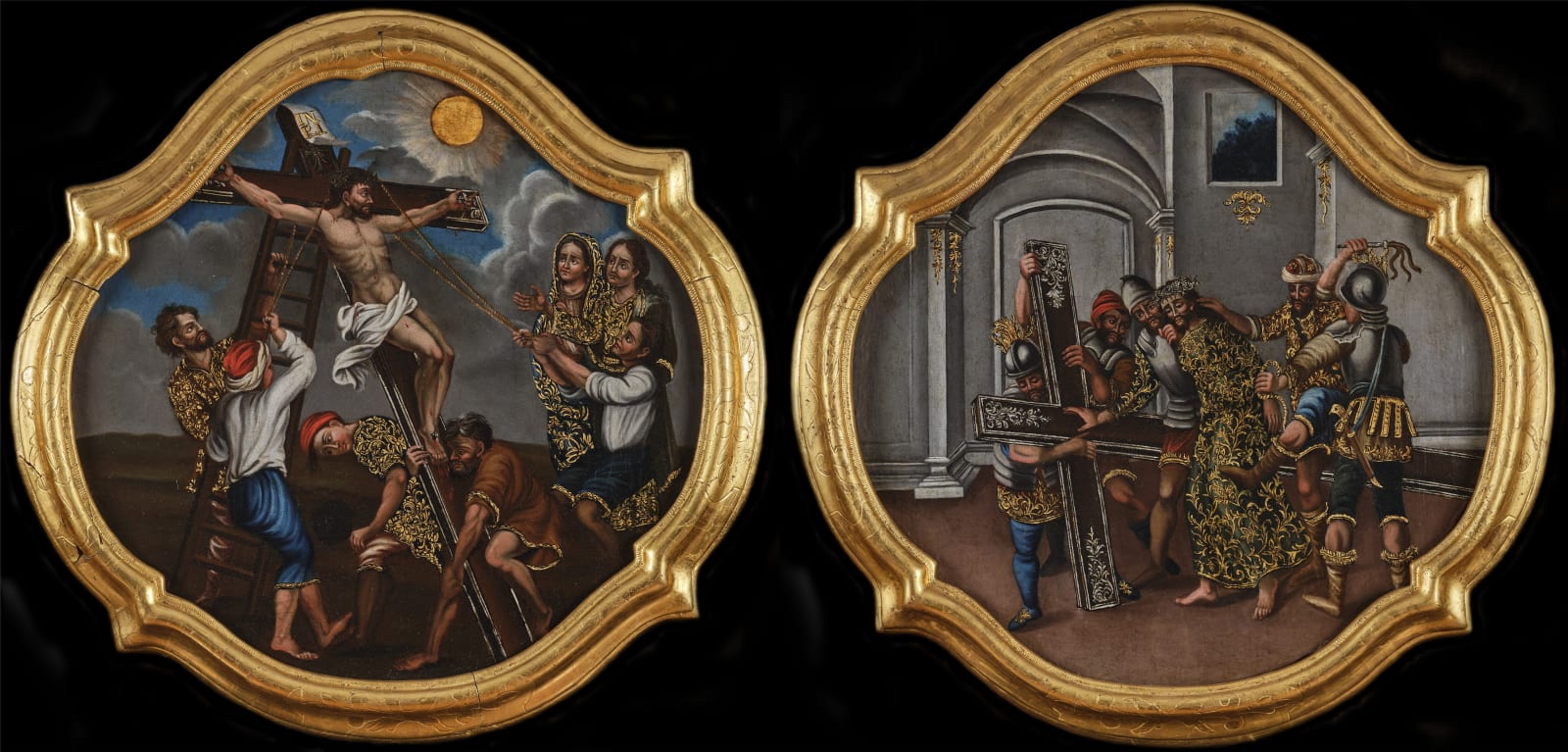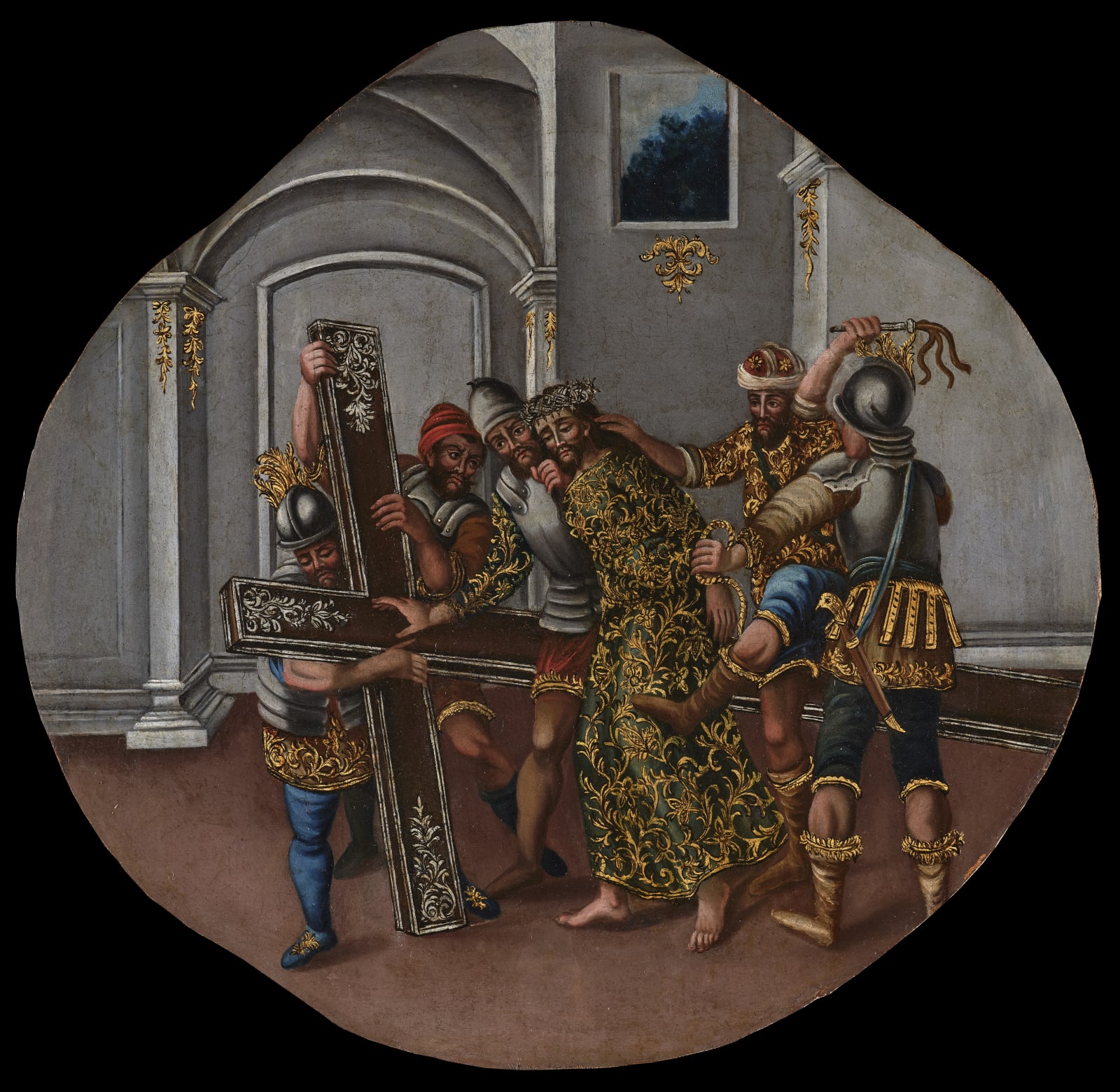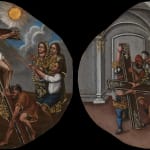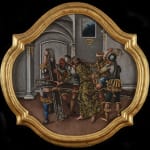JESUS NAILED TO THE CROSS & SIMON OF CYRENE HELPING JESUS
Further images
Provenance
Private Collection, Spain.
The term Via Curcis refers to the series of 14 stations providing the faithful with a sequential narrative depicting the stages on Christ’s Way of the Cross, from his condemnation by Pilate to his arrival in Calvary where his crucifixion, death and burial took place. Although the iconographic and devotional foundations of this Passion story date from the 15th century, becoming particularly popular in the years following the Counter-Reformation, it was not until the 18th century, thanks to the work of the Franciscan Leonard of Port Maurice (1676–1751), that the official model we see here became established, probably arriving in Guatemala through one of the many prints that crossed the Atlantic from Europe to the New World, where the practice of the Stations became completely integrated.
On this occasion, as is often the case for viceregal pictorial series, and all the more so for Guatemalan ones, what we have is an incomplete pictorial group where only two scenes have survived: Stations V and XI from the Vía Crucis, depicting Simon of Cyrene helping Jesus and Jesus nailed to the Cross.
In the first of the two canvases, the one relating to the Fifth Station, we find a portrayal of the moment the soldiers, seeing Christ’s exhaustion, forced one of the onlookers at the procession to help Jesus carry the cross. There are similar descriptions of the scene in three of the four Canonical Gospels, Luke, Mark and Matthew, with the latter commenting: “As they were going out, they met a man from Cyrene, named Simon, and they forced him to carry the cross.”
The second of the paintings, which presents the same fattura as the first one, depicts the Eleventh Station of the Vía Crucis, with Jesus being nailed to the hard beams of the Cross, witnessed by his Holy Mother. Although the Biblical accounts provided by the four Evangelists refer to the crucifixion, they do not include details such as how Christ was nailed to the cross, so the episode’s portrayal has allowed for a certain formal flexibility, with the scene sometimes depicting the exact moment of the crucifixion or, as is the case here, just moments later when, having nailed the Messiah in place, the cross was stood upright.
Having analyzed the iconographic aspects of the two compositions, we turn now to their artistic features, which require an examination of the pictorial trends of 18th-century Guatemala. This period is key to understanding the dynamics of the viceregal school, marked by a pictorial proliferation that was unprecedented in its artistic history thanks to the emergence of an increasingly prosperous and wellordered criollo society whose artistic requirements were both better informed and more demanding that those of previous generations.
This new criollo art had to adapt to the academic tools and rationale imported from the “Old Country”, though not without putting up some stylistic resistance with regard to the rigid norms being imposed on how reality was depicted, which stood in stark contrast to the indigenous artistic language. A form of painting thereby came about which, in spite of the obvious influence of the Mexican school, presents a markedly localized seal, the main defining features of which are perfectly reflected in these two beautiful, small-scale Passion scenes with their irregular mix of curved and straight borders, where the ingenuous nature of the figures depicted, and the perspective, is counterbalanced by the exquisite use of brocade. Although the (imposed) predominance of the religious subject matter, compared to a secular or civil theme, does restrict creative originality to a degree, the majesty with which the images in these works were decorated, with abundant gilding, marks a major point of departure from the Old World, while also serving to establish an individual pictorial identity.
Furthermore, and for the purposes of enabling interested readers to examine these and other Guatemalan paintings within a contextual framework that might help to understand their true value, I would like to comment on the factors that have contributed to the scant attention Art History scholars have dedicated to these works, whose story is very much a blank page waiting to be written.10 The truth is, that beyond the visual, aesthetic and technical specificities shared by the varying Latin American schools, Guatemala has had to deal with a number of conditioning factors that have denied researchers the chance to work with any kind of panoramic or comprehensive vision that might relate the artists with their works. Firstly, and this is a fundamental point, there is the fact that for centuries these works were mired in anonymity. An anonymity imposed by a utilitarian approach to art where form was deemed secondary, and recognition for it therefore unnecessary. Secondly, a factor alien to the artistic process but no less decisive, is that Central America was the victim of numerous earthquakes that spared no mercy when it came to the region’s artistic heritage, believed to have undergone great loss and damage, ruling out greater levels of scientific investigation.
However, and in spite of the above, we are confident that future scholars, showing consideration for the artistic works that were produced on the fringes of orthodox Western dynamics, will help to fill in the dates and places for the many paintings which, like these two we have before us here, once adorned the walls of Guatemala’s most important religious buildings.











